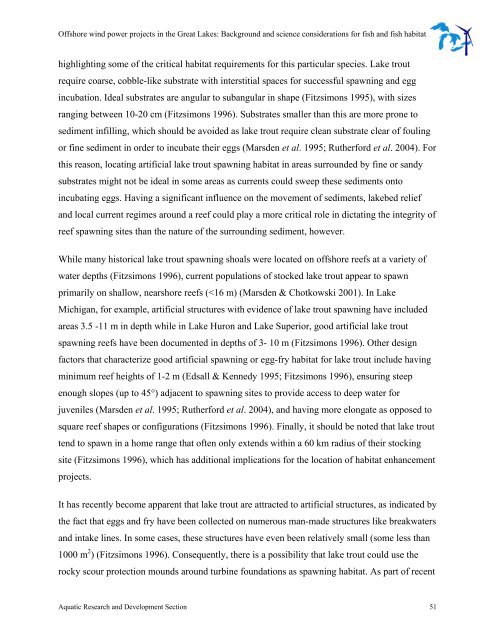Offshore Wind Power Projects in the Great Lakes - Ministry of ...
Offshore Wind Power Projects in the Great Lakes - Ministry of ...
Offshore Wind Power Projects in the Great Lakes - Ministry of ...
You also want an ePaper? Increase the reach of your titles
YUMPU automatically turns print PDFs into web optimized ePapers that Google loves.
<strong>Offshore</strong> w<strong>in</strong>d power projects <strong>in</strong> <strong>the</strong> <strong>Great</strong> <strong>Lakes</strong>: Background and science considerations for fish and fish habitat<br />
highlight<strong>in</strong>g some <strong>of</strong> <strong>the</strong> critical habitat requirements for this particular species. Lake trout<br />
require coarse, cobble-like substrate with <strong>in</strong>terstitial spaces for successful spawn<strong>in</strong>g and egg<br />
<strong>in</strong>cubation. Ideal substrates are angular to subangular <strong>in</strong> shape (Fitzsimons 1995), with sizes<br />
rang<strong>in</strong>g between 10-20 cm (Fitzsimons 1996). Substrates smaller than this are more prone to<br />
sediment <strong>in</strong>fill<strong>in</strong>g, which should be avoided as lake trout require clean substrate clear <strong>of</strong> foul<strong>in</strong>g<br />
or f<strong>in</strong>e sediment <strong>in</strong> order to <strong>in</strong>cubate <strong>the</strong>ir eggs (Marsden et al. 1995; Ru<strong>the</strong>rford et al. 2004). For<br />
this reason, locat<strong>in</strong>g artificial lake trout spawn<strong>in</strong>g habitat <strong>in</strong> areas surrounded by f<strong>in</strong>e or sandy<br />
substrates might not be ideal <strong>in</strong> some areas as currents could sweep <strong>the</strong>se sediments onto<br />
<strong>in</strong>cubat<strong>in</strong>g eggs. Hav<strong>in</strong>g a significant <strong>in</strong>fluence on <strong>the</strong> movement <strong>of</strong> sediments, lakebed relief<br />
and local current regimes around a reef could play a more critical role <strong>in</strong> dictat<strong>in</strong>g <strong>the</strong> <strong>in</strong>tegrity <strong>of</strong><br />
reef spawn<strong>in</strong>g sites than <strong>the</strong> nature <strong>of</strong> <strong>the</strong> surround<strong>in</strong>g sediment, however.<br />
While many historical lake trout spawn<strong>in</strong>g shoals were located on <strong>of</strong>fshore reefs at a variety <strong>of</strong><br />
water depths (Fitzsimons 1996), current populations <strong>of</strong> stocked lake trout appear to spawn<br />
primarily on shallow, nearshore reefs (
















